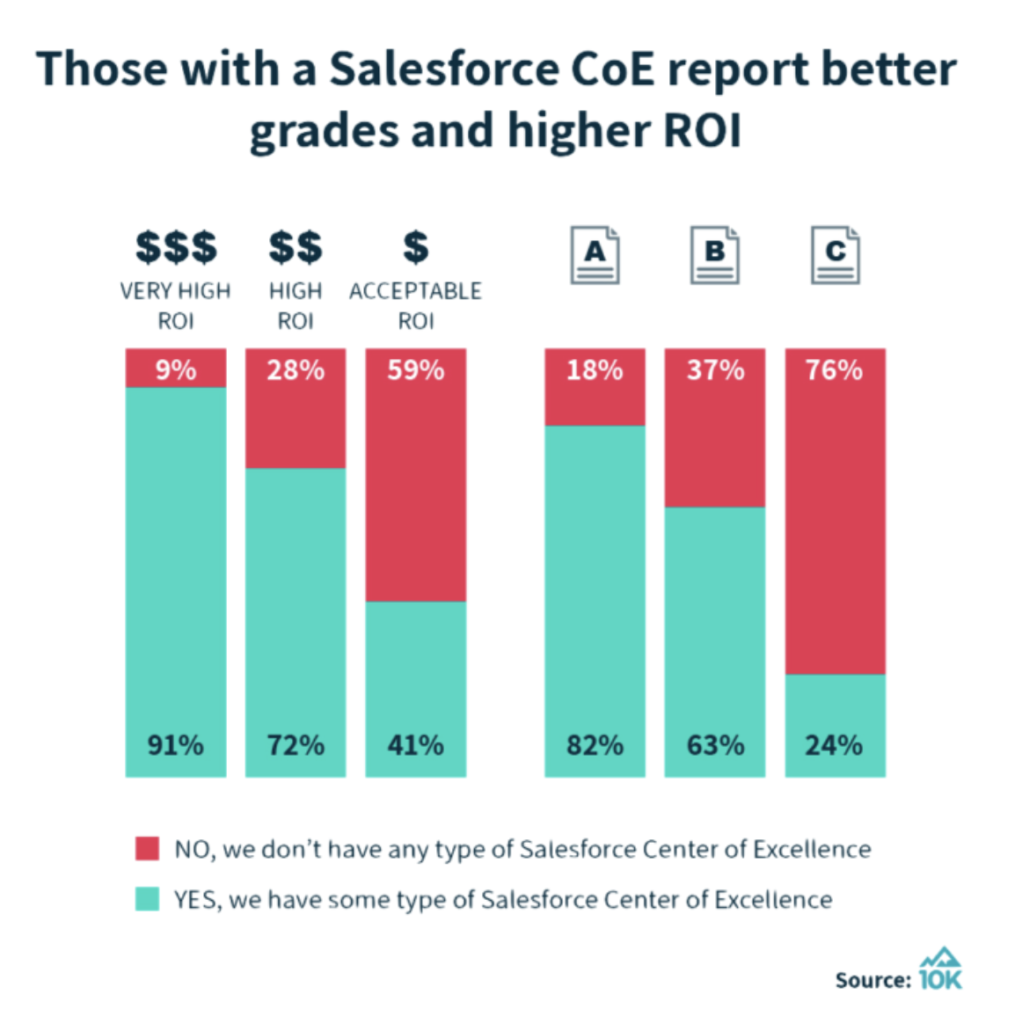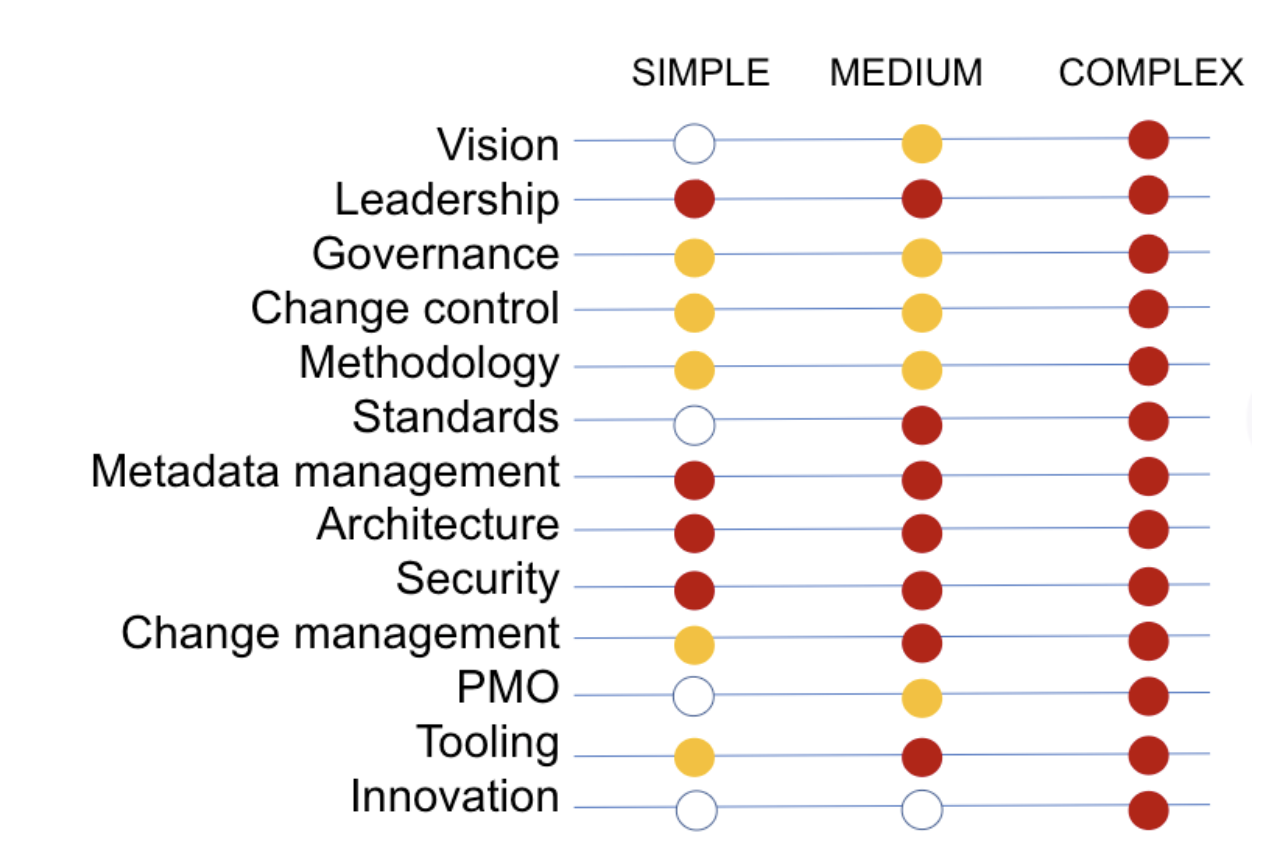
13 Pillars of Center of Excellence
Every week for the next 13 weeks we will post a blog that will help you establish a Center of Excellence. Each week will cover one of the 13 pillars of a Center of Excellence (COE).
But before we get started this post will look at the scope of a COE, the benefits, what size organization it applies to, and explore some of the myths and fears.
Scope of a COE
Successful implementations consider more than the core technology. They cover people, process, and technology. Often the root cause of a failed implementation is that the following were not put in place.
Whilst every organization is different, there are some common aspects. No matter what the size of the project, these need to be established. These are activities, not roles. The smaller the project, the lighter the touch.
Here is the overall scope or key pillars of a COE
- Vision: strategic vision and direction for Salesforce for both the business and IT
- Leadership: Steering Committee and key sponsors in business and IT
- Governance: overall control of strategic direction, business cases, investment and risk management
- Change control: management of changes to all aspects of the project
- Methodology: the implementation methodology covers people, process, and technology which includes business analysis, DevOps, and adoption.
- Standards: includes standards for business analysis, org documentation, metadata naming, coding, testing, communication, change management, and training
- Metadata management: control of the Salesforce metadata across the deployment pipeline
- Architecture: technical and data architecture of Salesforce and how it relates to the integrated systems
- Security: like architecture, security needs to be designed in, not bolted on as an afterthought.
- Change management: communications, organizational change, and training to get Salesforce adopted
- PMO: the Project Management Office that manages the COE activities
- Tooling: platforms/apps/ tools used to support the project
- Innovation: an innovation hub that builds out Salesforce prototypes to show the “art of the possible”
The benefits
Now that Salesforce is a major strategic platform it requires the proven approaches, tools, and skills of a COE to exploit the power and deliver the potential ROI at scale. Without them, the true differentiator of Salesforce — the super agile platform — is blunted. These approaches and tools are available in the ecosystem, and being applied by the global SIs and some large customers, but not yet been adopted across all customers.
The 10K Advisors Project to Program research identified that 91% of customers with a very high ROI and 82% of customers who felt they were A players had a Center of Excellence.

Phased by size
In all the COE Round tables that we have run, the question that is asked of the panelists most often is “How do I get started?” As the size and strategic importance of the Salesforce implementation increases, then each of the COE pillars becomes more important. We’ve tried to give some perspective in the diagram below. The definition of “size” is by no means prescriptive, but an indicator of strategic importance.
- Simple — Solo or small Admin team with limited developers. Fewer than 100 users
- Medium — Team with BA, Admin and Developers. SI engaged. External integrations. 100–1000 users
- Complex — Multi-org, multi-cloud. 1000+ users
The colors of the circles indicate how important it is to have that capability in place (white: not required, yellow: needed, red: mandatory). Ideally, every implementation has all of them, but we understand the trade-offs of running an org.

In practice
Back in May 2017, 3 Forrester analysts, John R Rymer, Liz Herbert, and Kate Leggett authored the research paper, Five ways to cut the risk of Salesforce. In that report they identified something they called “Salesforce@scale dilemma”. John Rymer from Forrester explains
“Salesforce@scale dilemma: a client chooses Salesforce CRM for its business responsiveness.
Typically, clients are impressed by Salesforce’s CRM applications, which are more modern and user-pleasing than older applications. And they love Force.com’s high productivity for developers to configure the CRM applications as well as create new applications from scratch.
Initial success breeds demands for more and more. As additional departments ask for Salesforce subscriptions, business leaders want to expand initial wins with Salesforce CRM into customer and/or partner engagement, marketing automation and analytics. New custom applications and customizations mushroom.
In addition, the complexity of scale crushes Salesforce’s responsiveness. As Salesforce use grows, innovation slows and flexibility evaporates. Why? Every app change risks breaking one of hundreds of data and process customizations, integration links, and third-party add-ons. The result: every change requires long and expensive impact-analysis and regression testing projects — killing the responsiveness that made Salesforce attractive at the start.
The Salesforce@scale dilemma is a challenge for clients to overcome, rather than an inevitable outcome of large-scale, strategic Salesforce implementations. It is a big issue because Salesforce has become a much more strategic supplier in technology strategies to win, serve and retain customers.”
That research paper was 2017 and 5 years on the challenges are arguably greater. Salesforce is now a far more powerful platform, with a broader reach, and is a strategic platform for more customers.
There are real-world benefits of a COE and a more structured approach as the Forrester and 10K Advisors research has shown. Often it is best to hear from customers. Here are both sides of the story from the Forrester article:
A food and beverage firm that adopted Salesforce for all its customer operations avoided the Salesforce@scale dilemma with planning and governance for adopting a platform as opposed to a CRM application and associated tools.
The firm set up a CoE and defined a common data model (including built-in and Custom Objects), a master data service, and a process rollout across the world. “One platform for all data and application building blocks means you need to be aligned on how you use those assets,” says a leader of the firm’s Salesforce CoE. “[The assets] have to fit together, and everyone needs an understanding of what is possible and what should be done.”
And a less successful outcome at a large US public sector agency. Sadly this is a more familiar story.
One department was happily using Salesforce’s core customer relationship management (CRM) application when a cloud-first directive changed everything for the worse. The directive was: move as many applications as possible to the cloud — including Salesforce.
The perception was that it almost didn’t matter what we did — if we put apps on cloud and Salesforce, we’d be successful,
The agency’s Salesforce Center of excellence (CoE) leader.
“The perception was that it almost didn’t matter what we did — if we put apps on cloud and Salesforce, we’d be successful,” recalls the agency’s Salesforce Center of excellence (CoE) leader.
The agency quickly added about 12,000 Salesforce seats in seven separate Orgs, lots of customizations, and many custom applications. As this expansion progressed, innovation on the agency’s core Salesforce apps slowed to a crawl, and operating costs rose. Updates and changes to enterprise processes and existing apps were now sluggish, although the agency still could quickly stand up isolated new applications.
“When you start adding custom code [to Salesforce], you need developers to make changes,” says the agency’s CoE leader. “And Salesforce becomes way more expensive to maintain.”
Sign up for
our newsletter
Subscribe to our newsletter to stay up-to-date with cutting-edge industry insights and timely product updates.





